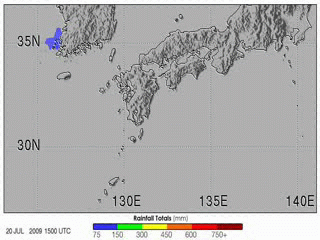Tập tin:Heavy Rains in Southern Japan.gif
Heavy_Rains_in_Southern_Japan.gif (320×240 điểm ảnh, kích thước tập tin: 8,35 MB, kiểu MIME: image/gif, có lặp, 268 khung ảnh, 8,0 s)
Lịch sử tập tin
Nhấn vào ngày/giờ để xem nội dung tập tin tại thời điểm đó.
| Ngày/giờ | Hình xem trước | Kích cỡ | Thành viên | Miêu tả | |
|---|---|---|---|---|---|
| hiện tại | 21:56, ngày 31 tháng 7 năm 2009 |  | 320×240 (8,35 MB) | Originalwana | {{Information |Description={{en|1=The 2009 summer monsoon brought torrential rains to south western Japan in July. This animatin shows rainfall estimates for southern Japan and the surrounding region from July 20–27. The most prominent feature is a larg |
Trang sử dụng tập tin
Có 2 trang tại Wikipedia tiếng Việt có liên kết đến tập tin (không hiển thị trang ở các dự án khác):
Sử dụng tập tin toàn cục
Những wiki sau đang sử dụng tập tin này:
- Trang sử dụng tại cs.wikipedia.org
- Trang sử dụng tại en.wikipedia.org
- Trang sử dụng tại fi.wikipedia.org
- Trang sử dụng tại id.wikipedia.org
- Trang sử dụng tại ja.wikipedia.org
- Trang sử dụng tại ms.wikipedia.org
- Trang sử dụng tại si.wikipedia.org
- Trang sử dụng tại te.wikipedia.org
- Trang sử dụng tại uk.wikipedia.org
- Trang sử dụng tại www.wikidata.org
- Trang sử dụng tại zh.wikipedia.org



